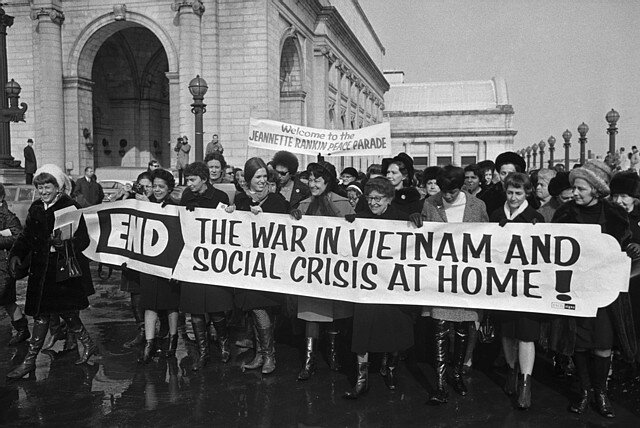Table of Contents
The 1960s were a transformative era marked by social upheaval, cultural revolution and a powerful rejection of the status quo. At the heart of this countercultural movement was the iconic slogan “Flower Power.” While the phrase may conjure images of colorful hippies and peace signs, its significance goes far beyond mere aesthetics. It symbolizes a profound shift in societal values and the influence of flowers played a central role in this movement.
The 1960s, often referred to as a decade of profound change and cultural revolution, indeed saw the emergence of a powerful countercultural movement that challenged established norms and values. Central to this era of transformation was the iconic slogan “Flower Power,” which, while evoking images of colorful hippies and peace signs, carried a significance that transcended mere aesthetics. It became a rallying cry for a generation seeking to rewrite the social script and promote ideals of love, peace and harmony and the influence of flowers played a central role in amplifying this message.
At its core, “Flower Power” was a rejection of the prevailing status quo, which was marked by political tensions, civil rights struggles and the ongoing conflict in Vietnam. It embodied a desire for a more peaceful and compassionate world and it was often associated with the anti-war movement. Flowers, with their delicate beauty and ephemeral nature, became potent symbols of this countercultural sentiment. They stood in stark contrast to the violence and aggression of the time, offering a vision of a world where beauty, love and peace could flourish.
The act of gifting flowers and wearing them in one’s hair became emblematic of the “Flower Power” movement. It was a non-violent form of protest, a statement that rejected the prevailing culture of war and conflict. Flowers, often given as tokens of affection and friendship, represented a desire for unity and harmony among people of all backgrounds and beliefs.
The use of flowers as a form of protest also had a universal appeal. Flowers transcend language and cultural barriers, making them a powerful symbol of peace that resonated not only in the United States but also in other parts of the world experiencing social and political upheaval. “Flower Power” became a global phenomenon, inspiring movements for change and peaceful resistance in various countries.
Moreover, the counterculture of the 1960s had a lasting impact on society. It laid the groundwork for the environmental movement, women’s rights and increased social awareness. The influence of “Flower Power” can still be seen today in the continued advocacy for peace, love and environmental stewardship.
In retrospect, the “Flower Power” slogan and the role of flowers in this transformative era serve as a reminder of the enduring power of symbols and the potential for positive change. It was a movement that dared to imagine a world where the simple act of offering a flower could hold the promise of a more peaceful and compassionate society. While the 1960s may be history, the message of “Flower Power” remains relevant, reminding us of the ongoing need for love, unity and the pursuit of a more harmonious world.
To expand your knowledge on this subject, make sure to read on at this location: Hippie | History, Lifestyle, Definition, Clothes, & Beliefs | Britannica
The Birth of Flower Power
The term “Flower Power” was first coined by the American poet Allen Ginsberg during a Vietnam War protest in 1965. It quickly became the emblematic phrase of the era, encapsulating the spirit of love, peace and non-violent resistance. At its core, Flower Power was a reaction to the turbulent political climate of the time, characterized by the Vietnam War and civil rights struggles.
The phrase “Flower Power,” birthed by the American poet Allen Ginsberg in the midst of a turbulent era, is more than just a catchy slogan; it’s a cultural touchstone that transcended words to become a symbol of profound social and political change. Its origin story is rooted in the context of a world grappling with the tumultuous Vietnam War and fervent civil rights movements and it served as a beacon of hope and a call for transformation.
Allen Ginsberg coined the term “Flower Power” during a Vietnam War protest in 1965, where the symbolic act of offering flowers to soldiers and authorities captured the essence of his message. It was a poetic response to the prevailing atmosphere of conflict, division and violence. At its heart, Flower Power was a peaceful, countercultural movement that advocated for love, peace and non-violent resistance as powerful tools for social change.
The emblematic phrase resonated deeply with the youth of the time, who saw it as a rallying cry for a more compassionate and harmonious world. It encapsulated a sense of unity, empathy and solidarity among those who embraced its message. Flower Power was not just about pretty blooms; it represented a profound belief in the transformative potential of love and non-violence as instruments of social and political reform.
Amidst the backdrop of the Vietnam War, civil rights struggles and a broader climate of social upheaval, Flower Power emerged as a countercultural movement that aimed to challenge the status quo. It rejected the prevailing norms of militarism and conformity, advocating instead for the power of peaceful resistance, artistic expression and communal living. The iconic imagery of young people offering flowers to soldiers and authorities became a visual symbol of this commitment to non-violence.
Flower Power wasn’t just about rejecting war and violence; it was a call to embrace the values of compassion, empathy and understanding. It encouraged individuals to look beyond their differences, challenge oppressive systems and work towards a more just and equitable society. It was a reminder that even in the face of seemingly insurmountable challenges, the power of love and unity could be a force for positive change.
While the 1960s may be remembered for its countercultural movements, Flower Power remains a timeless reminder of the enduring potential of peace and love to shape the world. It continues to inspire and influence generations, serving as a testament to the capacity of individuals to come together in pursuit of a more compassionate and harmonious society. In a world still grappling with conflicts and injustices, the legacy of Flower Power lives on as a reminder that the power of love and non-violence can be a beacon of hope and a catalyst for transformation.
For additional details, consider exploring the related content available here Hippie | History, Lifestyle, Definition, Clothes, & Beliefs | Britannica

Flowers as Symbols of Peace and Love
Flowers became potent symbols of the counterculture’s ideals. They were offered as gestures of peace and love at protests and gatherings. Flower-adorned clothing, especially the ubiquitous flower crown, became a fashion statement and a declaration of one’s affiliation with the counterculture movement. Flowers, with their natural beauty and ephemeral nature, represented a longing for a more harmonious and interconnected world.
During the counterculture movement of the 1960s, flowers took on a profound role beyond their aesthetic charm. They became powerful symbols that resonated with the ideals of peace, love and social change. In a time marked by social and political turbulence, flowers served as a visual language of unity and hope.
At protests and gatherings, flowers were offered as gestures of peace and love, creating a stark contrast to the prevailing atmosphere of unrest. Their fragility and fleeting beauty served as a poignant reminder of the transience of life and the urgent need for change. The simple act of handing someone a flower was a way to express a desire for a more compassionate and understanding world.
Flowers also found their way into fashion, becoming an integral part of counterculture attire. The flower crown, in particular, became an iconic fashion statement. Wearing a flower crown was not just a matter of style but a declaration of one’s affiliation with the counterculture movement. It symbolized a rejection of societal norms and a commitment to a more peaceful and communal way of life.
In addition to fashion, the counterculture embraced the use of flowers in art and music. Album covers, posters and stage setups often featured vibrant floral designs, reinforcing the movement’s connection to nature and its aspiration for a more harmonious world.
The appeal of flowers during this era lay in their natural beauty and their ability to evoke a sense of wonder and unity. In a time of division and unrest, they served as a unifying force, reminding people of the interconnectedness of all living things and the importance of living in harmony with nature.
Though the counterculture movement of the 1960s has passed into history, the symbolism of flowers as agents of peace, love and unity endures. They continue to be used as symbols of hope and positive change in various social and political movements, demonstrating the timeless power of nature to inspire and bring people together in the pursuit of a better world.
If you’d like to dive deeper into this subject, there’s more to discover on this page: How the Vietnam War Empowered the Hippie Movement | HISTORY

Flower Children and Communal Living
The 1960s saw the rise of a generation known as “flower children.” These young people embraced a lifestyle centered on communal living, rejecting materialism in favor of a more holistic and environmentally conscious existence. Flowers played a significant role in these communes, adorning living spaces and gardens and symbolizing the shared values of peace, love and sustainability.
The 1960s was a decade of profound societal transformation and the emergence of the “flower children” was one of its defining cultural movements. These young individuals, often referred to as hippies, sought an alternative way of living that stood in stark contrast to the consumerism and conformity of the era. At the heart of their countercultural philosophy was a commitment to ideals rooted in peace, love and sustainability.
A Blossoming of Ideals: For the flower children, flowers were not just decorative elements; they were symbols of their ideals. Flowers represented peace, a powerful message in a decade marked by the turbulence of the Vietnam War and civil rights struggles. The act of offering a flower, as famously seen in the “flower power” movement, became a peaceful protest against violence and war.
The Communal Lifestyle: Communal living was a hallmark of the flower child movement. These young people often formed intentional communities where they could live in harmony with one another and with nature. Flowers played an integral role in these communal spaces, adorning homes, gardens and even hair. They brought a touch of nature’s beauty into their daily lives, fostering a connection with the environment and a rejection of materialism.
Holistic and Environmentally Conscious Living: The flower children embraced a holistic approach to life, emphasizing spiritual growth, creativity and mindfulness. They sought to minimize their impact on the planet by promoting sustainability long before it became a mainstream concept. Flower gardens and organic farming were common features of their communes, reflecting a commitment to responsible and eco-friendly living.
The Legacy of Flower Power: While the flower child movement may have peaked in the 1960s, its legacy endures. The ideals of peace, love and environmental consciousness continue to influence subsequent generations. Today, the symbolism of flowers as emblems of unity, beauty and positive change remains a potent cultural touchstone.
In essence, the flower children of the 1960s left a lasting mark on society, not only through their rejection of societal norms but also through their embrace of a simpler, more harmonious way of life. Their use of flowers as symbols of hope, peace and a sustainable future serves as a reminder of the enduring power of nature and the human spirit to effect positive change in the world.
For a comprehensive look at this subject, we invite you to read more on this dedicated page: Flower Children Cartoons and Comics – funny pictures from …

Flower Power and Music
Music was a driving force behind the counterculture and flowers were ever-present in this aspect as well. Iconic music festivals like Woodstock in 1969 featured flower-inspired aesthetics and songs like “San Francisco (Be Sure to Wear Flowers in Your Hair)” by Scott McKenzie became anthems of the movement. Flowers were not just decorations but a way to express a deep connection to the natural world and a rejection of the mainstream.
Music and flowers, two powerful symbols of the counterculture movement of the 1960s, were intertwined in a way that transcended mere aesthetics. They were, in essence, the heartbeat of a cultural revolution that sought to redefine societal norms and values.
The iconic music festivals of the era, with Woodstock at the forefront, were not just gatherings for music enthusiasts; they were expressions of a profound shift in collective consciousness. These festivals featured flower-inspired aesthetics, from the colorful, hand-painted buses adorned with vibrant floral motifs to the garlands of flowers adorning the hair and clothing of attendees. The sight of a sea of flowers was emblematic of the movement’s ideals: peace, love, unity and a return to nature.
The song “San Francisco (Be Sure to Wear Flowers in Your Hair)” by Scott McKenzie captured the essence of this era. It wasn’t just a song; it was an anthem that encouraged people to embrace the symbolism of flowers as a means of self-expression. Wearing flowers in one’s hair became a statement of solidarity with the counterculture, a way of saying, “I am part of this movement for change.”
Flowers in this context were far more than decorations; they were a profound expression of a deep connection to the natural world. They represented a rejection of the mainstream values and consumerist culture that dominated the era. In the simple act of wearing or sharing a flower, individuals were aligning themselves with a different set of values—one that celebrated simplicity, community and a return to the fundamental rhythms of life.
Moreover, flowers became a form of non-verbal communication, a silent language that transcended barriers of age, race and background. Giving someone a flower was a gesture of peace, a way of saying, “I see you as a fellow traveler on this journey of change.” It fostered a sense of unity and togetherness that was central to the counterculture’s vision of a better world.
In retrospect, the synergy between music and flowers during this era was a reflection of the profound desire for transformation and a reconnection with the human spirit. It reminds us that cultural movements are not just about words and ideologies; they are also about symbols and expressions that resonate deeply with our shared humanity. The counterculture’s use of flowers as a symbol of hope, change and unity remains a powerful testament to the enduring impact of music and nature on our cultural and social landscapes.
To delve further into this matter, we encourage you to check out the additional resources provided here: Hippie | History, Lifestyle, Definition, Clothes, & Beliefs | Britannica

Environmental Activism
The counterculture of the 1960s also laid the groundwork for the modern environmental movement. Many of those who identified with Flower Power were passionate advocates for the planet. They saw the Earth as a fragile and interconnected ecosystem, much like the delicate petals of a flower. This environmental consciousness led to the first Earth Day in 1970, a significant event that continues to shape our approach to environmentalism today.
The counterculture of the 1960s was a remarkable period of social and cultural transformation and it not only championed the values of peace, love and self-expression but also sowed the seeds of the modern environmental movement. Many of those who identified with Flower Power were not only advocating for a more open and compassionate society but were also passionate advocates for the planet.
A Paradigm Shift: Flower Power represented a paradigm shift in how people perceived the world around them. It encouraged a deeper understanding of the Earth as a fragile and interconnected ecosystem. This perspective was akin to recognizing the intricate beauty and balance of a delicate flower, where every petal and component played a vital role in the overall health and vitality of the whole.
The Earth as a Living Organism: The environmental consciousness that emerged during this time viewed the Earth as a living organism, with ecosystems mirroring the intricate patterns and cycles of nature. Just as a flower relies on sunlight, water and nutrients to thrive, so too did the Earth depend on the delicate balance of its elements, species and resources.
The Birth of Earth Day: This newfound environmental awareness culminated in the first Earth Day in 1970. It was a watershed moment, bringing together millions of people from diverse backgrounds and ideologies to voice their concerns about environmental degradation. Earth Day galvanized support for environmental protection and conservation efforts, leading to the establishment of critical environmental policies and regulations.
A Lasting Legacy: The legacy of that first Earth Day endures today. It laid the groundwork for a more concerted global effort to address environmental challenges, including pollution, habitat destruction and the effects of climate change. The ethos of the counterculture era, with its emphasis on interconnectedness and responsibility, remains woven into the fabric of modern environmentalism.
Beyond Earth Day: Earth Day was just the beginning. In the decades that followed, the environmental movement continued to evolve, embracing diverse issues such as clean energy, biodiversity conservation and sustainable agriculture. Environmental advocates worldwide draw inspiration from the spirit of Flower Power, recognizing that the choices we make today have a profound impact on the future of our planet.
Individual and Collective Responsibility: The counterculture era taught us that individuals have the power to effect change and that collective action is essential to address global challenges. Like the petals of a flower working in harmony to create its beauty, people around the world recognize the need to collaborate, advocate for the environment and protect the fragile balance of our planet.
In essence, the counterculture of the 1960s, with its embrace of Flower Power, not only reshaped societal values but also planted the seeds of environmental consciousness that continue to flourish today. The vision of the Earth as a delicate and interconnected ecosystem, much like a beautiful flower, reminds us of our responsibility to nurture and protect the planet for future generations, embodying the enduring legacy of the Flower Power era.
If you’d like to dive deeper into this subject, there’s more to discover on this page: Hippies’ proud legacy: peace, love, activism

Legacy of Flower Power
The influence of Flower Power extended far beyond the 1960s. Its ideals of peace, love and environmental stewardship remain relevant and influential. The use of flowers as symbols of protest and unity persists in various social and political movements. Additionally, the counterculture’s emphasis on individual freedom and self-expression has left an indelible mark on art, fashion and music.
“The influence of Flower Power extended far beyond the 1960s. Its ideals of peace, love and environmental stewardship remain relevant and influential, resonating with subsequent generations. The spirit of Flower Power serves as a timeless reminder that positive change can be achieved through non-violence, unity and a deep connection to nature.
In the realm of environmental stewardship, the legacy of the 1960s counterculture lives on. The concerns raised by activists of that era about pollution, deforestation and the importance of preserving our planet have only grown in urgency. Today’s environmental movements, such as the global efforts to combat climate change and protect biodiversity, draw inspiration from the eco-conscious roots of Flower Power. The simple act of planting trees or adorning protest signs with flowers continues to symbolize the fight for a healthier planet.
Flowers as symbols of protest and unity have not lost their potency. They have reemerged as powerful emblems in various social and political movements worldwide. From the use of sunflowers in anti-nuclear protests to the Women’s Marches where participants carry floral arrangements, flowers transcend language barriers, conveying messages of hope, resilience and solidarity. These delicate blooms remain a universal symbol of resistance against oppression and injustice.
Furthermore, the counterculture’s emphasis on individual freedom and self-expression has left an indelible mark on the realms of art, fashion and music. The vibrant and unconventional styles of the 1960s continue to inspire contemporary fashion designers and artists. The notion that one can express their unique identity freely, without conforming to societal norms, has become a fundamental aspect of modern artistic and creative endeavors. The music of that era, with its anthems of love and protest, continues to be celebrated and sampled by musicians across genres, ensuring that the spirit of Flower Power lives on in melody and verse.
In essence, the legacy of Flower Power is a testament to the enduring power of ideals that transcend time. It reminds us that the pursuit of peace, love and environmental responsibility is an ongoing journey, one that requires the collective effort of each new generation. As we look back on the Flower Power movement of the 1960s, we are not merely examining history but drawing from its wellspring of inspiration to continue pushing for positive change, fostering unity and celebrating the beauty of the world around us.”
Should you desire more in-depth information, it’s available for your perusal on this page: Counterculture Movement · Civil Rights Digital History Project · exhibits

In conclusion, the Flower Power movement of the 1960s was a revolutionary moment in history. It showcased the profound impact that symbols, in this case, flowers, can have on cultural and societal change. As we look back on this era, we are reminded of the enduring power of love, peace and the beauty of the natural world. The influence of flowers in 1960s counterculture continues to inspire us to strive for a better, more harmonious world.
In conclusion, the Flower Power movement of the 1960s was a revolutionary moment in history that transcended mere aesthetics. It wasn’t just about adorning one’s hair with wildflowers or offering a daisy to a stranger; it was a powerful statement of unity, a call for change and a rejection of the prevailing norms. It showcased the profound impact that symbols, in this case, flowers, can have on cultural and societal change.
The sight of young people offering flowers to stoic law enforcement officers during anti-war protests was a poignant symbol of non-violence, a reminder that even in the face of adversity, love and peace can prevail. It was a bold assertion that the power of compassion and harmony could overcome the forces of division and discord.
As we look back on this era, we are reminded not only of the floral crowns and tie-dye shirts but also of the enduring power of love, peace and the beauty of the natural world. The influence of flowers in 1960s counterculture continues to resonate with us, serving as a timeless reminder that change is possible through unity, empathy and a shared appreciation of the simple wonders of our planet.
The Flower Power movement’s legacy lives on, inspiring us to strive for a better, more harmonious world. It encourages us to recognize the strength in coming together, to value the inherent beauty in nature and to always believe in the transformative power of love, peace and the symbolism of a single flower. In an ever-changing world, the essence of Flower Power endures as a beacon of hope and a call to make the world a more compassionate and peaceful place for generations to come.
Additionally, you can find further information on this topic by visiting this page: 1960-1969
More links
Don’t stop here; you can continue your exploration by following this link for more details: How the Vietnam War Empowered the Hippie Movement | HISTORY
